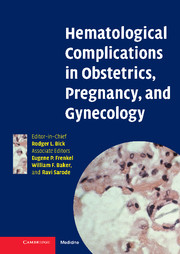Book contents
- Frontmatter
- Contents
- List of contributors
- Preface
- 1 Disseminated intravascular coagulation in obstetrics, pregnancy, and gynecology: Criteria for diagnosis and management
- 2 Recurrent miscarriage syndrome and infertility caused by blood coagulation protein/platelet defects
- 3 Von Willebrand disease and other bleeding disorders in obstetrics
- 4 Hemolytic disease of the fetus and newborn caused by ABO, Rhesus, and other blood group alloantibodies
- 5 Hereditary and acquired thrombophilia in pregnancy
- 6 Thromboprophylaxis and treatment of thrombosis in pregnancy
- 7 Diagnosis of deep vein thrombosis and pulmonary embolism in pregnancy
- 8 Hemorrhagic and thrombotic lesions of the placenta
- 9 Iron deficiency, folate, and vitamin B12 deficiency in pregnancy, obstetrics, and gynecology
- 10 Thrombosis prophylaxis and risk factors for thrombosis in gynecologic oncology
- 11 Low molecular weight heparins in pregnancy
- 12 Post partum hemorrhage: Prevention, diagnosis, and management
- 13 Hemoglobinopathies in pregnancy
- 14 Genetic counseling and prenatal diagnosis
- 15 Thrombocytopenia in pregnancy
- 16 Neonatal immune thrombocytopenias
- 17 The rational use of blood and its components in obstetrical and gynecological bleeding complications
- 18 Heparin-induced thrombocytopenia in pregnancy
- 19 Coagulation defects as a cause for menstrual disorders
- Index
- Plate section
- References
6 - Thromboprophylaxis and treatment of thrombosis in pregnancy
Published online by Cambridge University Press: 01 February 2010
- Frontmatter
- Contents
- List of contributors
- Preface
- 1 Disseminated intravascular coagulation in obstetrics, pregnancy, and gynecology: Criteria for diagnosis and management
- 2 Recurrent miscarriage syndrome and infertility caused by blood coagulation protein/platelet defects
- 3 Von Willebrand disease and other bleeding disorders in obstetrics
- 4 Hemolytic disease of the fetus and newborn caused by ABO, Rhesus, and other blood group alloantibodies
- 5 Hereditary and acquired thrombophilia in pregnancy
- 6 Thromboprophylaxis and treatment of thrombosis in pregnancy
- 7 Diagnosis of deep vein thrombosis and pulmonary embolism in pregnancy
- 8 Hemorrhagic and thrombotic lesions of the placenta
- 9 Iron deficiency, folate, and vitamin B12 deficiency in pregnancy, obstetrics, and gynecology
- 10 Thrombosis prophylaxis and risk factors for thrombosis in gynecologic oncology
- 11 Low molecular weight heparins in pregnancy
- 12 Post partum hemorrhage: Prevention, diagnosis, and management
- 13 Hemoglobinopathies in pregnancy
- 14 Genetic counseling and prenatal diagnosis
- 15 Thrombocytopenia in pregnancy
- 16 Neonatal immune thrombocytopenias
- 17 The rational use of blood and its components in obstetrical and gynecological bleeding complications
- 18 Heparin-induced thrombocytopenia in pregnancy
- 19 Coagulation defects as a cause for menstrual disorders
- Index
- Plate section
- References
Summary
Introduction
The true incidence of thromboembolic complications in pregnancy and the distribution of these events between the antenatal and postnatal periods are unknown. Early studies have estimated an incidence of symptomatic venous thrombosis during pregnancy using radiographic investigations between 0.5 and 3.0 per 1,000 deliveries. Lindqvist et al. used the Swedish national registries of births to investigate the number of objectively confirmed DVT between 1990 and 1993. The overall incidence of venous thromboembolic events was 1.3 per 1,000 deliveries in contrast to McColl et al. with 0.8 per 1,000 deliveries, Gherman et al. with 0.6 per 1,000 deliveries and Simpson et al. with 0.85 per 1,000 deliveries. More recent studies have demonstrated that antepartum deep vein thrombosis (DVT) is at least as common as postpartum DVT (Fig. 6.1) and can occur at any time during gestation, although pulmonary emboli (PE) remains more common postpartum. Earlier postpartum ambulation and discharge of patients from the hospital may have resulted in a relative decrease in postpartum events as compared to antepartum period, but the daily risk of thromboembolic complication was therefore highest in the postpartum period.
In a retrospective study McColl et al. described an incidence of DVT at 0.5 per 1,000 deliveries in the antenatal period and 0.21 in the puerperium. The incidence of pulmonary embolism was 0.07 per 1,000 deliveries and 0.08 in the puerperium respectively.
- Type
- Chapter
- Information
- Publisher: Cambridge University PressPrint publication year: 2006



